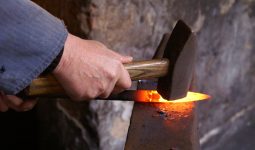Various types of clamps are available for every project imaginable. Check out our list to see which clamps you need if you’re working on specific tasks or renovating anywhere, whether in your home or elsewhere.
In summary, clamps are very handy whenever you’re gluing or need two or more things held together so you can attach, assemble, or work on them.
Since you only have two hands, it makes sense to let clamps do the work so you can focus on other tasks.
Clamps are affordable, given the enormous assistance they can provide.
Furthermore, a clamp is a tool that is specifically used to hold or secure two objects tightly together to prevent movement or separation by applying pressure inward.
When a device is temporarily used to position components during a construction or woodworking project, the term “clamp” is frequently used.
Here are some of the different types of clamps. Please read on.
Hand Clamp
Hand clamps are hand-operated tools to hold or position the workpieces during assembly and manufacturing.
The primary requirements include the clamp features and some intended applications, such as the clamp type or grip range.
Hand clamps are typically available in an extensive range of designs, including bar, draw, parallel, and toggle.
They can be used for various tasks, including book binding, picture framing, door making, and other manufacturing processes.
Laboratory glassware, also included here, is typically used with clamps.
Mechanical Clamp
Mechanical clamps are tools used to hold hoses or tubes in place on the ends of pipe spuds.
The material, diameter, and clamp type are the details of such clamps.
These tools, also known as hose clamps, are employed anywhere a flexible fluid connection is required.
However, considering the radiator’s inlet spud and the water pump of an automobile.
Depending on the application, these can be designed as single-use or reusable devices and come in various sizes and materials, such as metal or plastic.
G or C Clamp
These are extremely useful and widely employed. This is the image that most people consider when they think of a clamp. It holds a table workpiece or clamps two project pieces together.
Finding a jaw that will meet your project’s demands is straightforward because jaw openings can range from about one inch to more than eight inches.
Due to its swivel head, the screw section typically can clamp onto a variety of surfaces.
Hand Screw Clamp
These clamps, also known as “toolmaker’s clamps,” are typically employed when working with metalwork.
Because the jaws can easily be adjusted to fit and hold angled material in place, they are excellent for repairing furniture.
Although some businesses now produce them in wooden versions, they are typically made entirely of steel, making them very durable and hardy.
Sash Clamp
This clamp is used when working on large projects like table tops, doors, cabinets, or sash windows. More than one must be used at once to ensure a firm hold on the project.
They have a fixed jaw attached to a long, flat bar that is very heavy. This fixed jaw has a screw that you can turn.
Furthermore, they have a sliding jaw, so you can move the entire length of the clamp before it is locked into place to secure the materials.
They help clamp large projects together while the glue dries. They are a more advanced, more extended version of the bar clamp.
Pipe Clamp
These clamps, also known as gluing clamps, are very similar to sash clamps, but instead of a flat bar, the long metal piece is a round shaft.
The length of the pipe determines the length of the clamp; however, you can easily extend the clamp’s length by incorporating additional tubes. Therefore, they are very functional and straightforward to use.
Furthermore, they are an excellent investment for the DIYer on a tight budget because, after the initial outlay, they are simple and inexpensive to lengthen.
The clamp’s jaw is adjustable and easily moved from its initial position. To ensure a project is held tightly and securely, it is placed against the jaw, and the clamp is slowly tightened.
Spring Clamp
These clamps are widely used and have various applications. They come in various sizes and can be used to secure wire for beading and jewelry-making projects or clamp together projects for the woodworking industry.
PVC covers are typically added to the handles to prevent skin damage and are frequently added to the tips. If you remove these covers, you can easily use these clips for soldering.
Furthermore, these clamps are more challenging to open thanks to the tension spring, which guarantees they will hold the object tightly once closed.
Web Clamp
These clamps make working on frames much easier. They have nylon bands that can be tightened with a ratchet and wrapped delicately but securely around the item you’re working on. The nylon protects the object from damage while holding it in place.
They can be used either alone or in conjunction with corner gripping pieces to distribute the clamp’s pressure and prevent piece damage evenly.
Bench Vise
In reality, these parts have parallel and fixed jaws that are both easily adjustable with a screw. You can move your project quickly from one location to another with the help of some bench vises that are portable and can be screwed or clamped onto a workbench.
Using a vise eliminates the risk of the object you are working on shifting or moving while drilling, sawing, or sanding.
Mitre Clamp
These clamps will maintain the right angle between two pieces with mitered ends. Typically, they have screws that fit underneath the frame and a bit that will clamp down onto the frame to hold them in place.
At the same time, more complex miter clamps with rigid bodies and movable jaws are available. When appropriately used, even the simpler version of this clamp can quickly and easily complete the task.
Quick Action Clamp
These clamps are strong but simple to use without much hassle. You can efficiently operate them with just one hand.
Most of them have a light release that allows a person to pull it with just one finger. Due to their similar construction, this clamp is frequently mistaken for a sealant gun.
Quick Grip
These clamps allow the user to grasp the project or object quickly with just one hand. Since they have adjustable pressure, they are perfect for various uses.
It’s important to remember that these types of clamps work best with thinner materials or pieces. They won’t hold thicker items together as well because the jaws do not close square to each other.
Trigger Clamp
These clamps are simple to use with just one hand. A trigger adjusts the clamp’s head and jaws. They are incredibly adaptable and robust. Unlike many others used in the workshop, these clamps can be used inside the home and in the garden.
Drill Press Clamp
Users can make an exact and clean cut every time they use their equipment thanks to the clamps, which are specifically made to hold materials and boards to the drill press table.
They typically have a quick release that makes it simple to put the clamp onto the material you are working on and release it.
Furthermore, they typically have an easy way to adjust the tension of the clamp, making using your drill press incredibly safe and precise.
Screw Clamp
These clamps are highly sturdy and provide excellent stability, much like a power clamp. However, their primary distinction is in how they are used. These clamps have a thread and handle.
You must screw that, in contrast to power clamps, which can open and close in a single swift motion. Also, the action still takes a bit longer despite the thread’s unique design to speed up the process as much as possible.
Speed Clamp
This long metal bar has numerous serrations pressed firmly against the project or item. It will hold the adjustable head in place. The serrations on the sliding headlock prevent the sliding head from slipping as the user applies pressure to the clamp’s head.
F Clamp
Bar clamps come in various lengths, but most are pretty long. Enabling users to work on more significant projects without worrying about the objects’ stability.
Since the bar has a flat surface, it is simple to set the project on it before tightening the clamp’s head around it. The majority of significant projects require the use of basic bar clamps, which come in various designs and variations.
Cardellini Clamp
The jaws on Cardellini clamps are used to clamp onto the tubing. They can be used on rectangular, square, or even round tubing without any issues due to their design.
Additionally, you can use them to grip objects, flat clamp items, or even mount lights for a theater. Although all clamps are susceptible to damage if overtightened.
They are particularly vulnerable because of their construction and how the jaws’ edges rub against one another when the clamp is used. This requires extra caution on the user’s part when tightening and adjusting this particular type of clamp.
Flooring Camp
When a carpenter installs a floor, they use these simple clamps. They aid in maintaining tongue-and-groove boards in position so that they can be securely fastened down and won’t move throughout the installation. They typically have a 10-board capacity and must be used with other flooring clamps.
Gripe Clamp
This is a very basic clamp employed to assist in the construction of a clinker boat. To prevent slipping, it functions by holding the strake while it is being fitted and attached. Due to its single purpose, it is more challenging to locate in stores than other clamps.
Kant Twist Clamp
These clamps serve various functions and combine the advantages of parallel and C clamps. Thanks to their free-floating jaws, they can quickly adapt to surfaces that aren’t parallel and won’t move from the center when you apply pressure to the jaw. They are straightforward to use and give your clamp a lot of movement.
Toggle Clamp
These clamps feature a handle for controlling the clamp, a bar to secure the object you’re working on, and levers and pins to increase the force.
When you apply inward pressure, they firmly hold the things and ensure they can’t separate or move. You can use them for drilling, milling, woodworking, and metalworking.
Clip Hangers
These are modest, simple clamps attached to hangers. They enable wearers to clip their garments to the hanger rather than drape or fold them over the rod.
They are easily opened and closed with just a few fingers and require little force. They can be used as bag clips to securely close an open bag of chips and as clothes hangers.
Picture Frame Clamp
A miter clamp can hold two pieces of material that have been mitered together, but it is also used to hold four parts together to make a picture frame.
The clamp holds the frame’s mitered edges in place while all fitting together perfectly. You can find and purchase designs in a wide variety. A central screw in one of the most common designs adjusts the clamp and the frame’s parts.
Wire Rope Clamp
These clamps, also called clips, are employed to assist in securing a wire rope loop’s loose end to the rope itself. It consists of a U-shaped bolt, a saddle, and two nuts.
Due to its limited use, it may be necessary to order one precisely so that you have the appropriate size and style. These clamps are not readily available in most stores.
Marmon Clamp
These powerful band clamps make it simple and quick to clamp two cylinders together. These ring clamps are available in various sizes and strengths depending on the application.
Also, when you need to separate the two objects quickly, you clamp them together; they are ideal. Therefore, they are perfect for applications like flexible aircraft fuel lines.
Hose Clamp
Although very similar to Marman clamps in appearance and function. These clamps are available in various types and styles and do not apply as much pressure.
You can use them in the car or throughout the house, and they are frequently used when duct tape does. They will last longer because they produce a slightly more durable fix than duct tape.
They come in screw, spring, ear, and wire varieties, and each has its advantages and disadvantages, as well as the best time to use them.
Mogen and Gomco Clamp
Typically, these clamps are used for circumcision. They are advantageous because they are simple to use, don’t require any assembly before use, and leave behind minimal scarring.
They are a medical clamp, but non-physicians who work in environments with few resources can use them. You must thoroughly sanitize them to stop the spread of the disease because you can use them more than once.
Foerster Clamp
These surgical clamps have a circular eyelet on the end. This eyelet is excellent for grabbing sponges and lung tissue during surgery and is also referred to as the sponge stick or a sponge clamp.
They can be used with a sponge to gently remove any fluid accumulated in the surgical area and apply pressure to any bleeding. They are also occasionally employed for tissue dissection and frequently used for piercings outside of medicine.
Pennigton Clamp
Due to its triangular eyelet, this clamp is also known as a Duval clamp. It works well during surgery to grab and hold onto the tissue. They are frequently utilized during intestinal and rectal surgeries.
Hemostatic Clamp
This clamp is known by various names, including pean, arterial forceps, and hemostats. It is frequently used in all types of surgery to control bleeding.
Because of the force with which they clamp shut, they effectively close vessels and stop them from bleeding before ligation.
The handle contains a locking mechanism that causes the tip, which can be straight or curved, to close.
This mechanism’s teeth interlock, making it simple for the user to change the clamp’s tensile strength.








